

Note: There are many variations out there for the spelling and phonetic pronunciation of foreign-young-warrior, (Gallowglass is an anglicised version of Galloglaich) however throughout this web page I have used the term Galloglaich as plural and Galloglach as a singular term which in my opinion I belive reflect an accurate and realistic terminology.
having every man of them a kind of battle-axe and they be named Galloglaich.
These sort of men be those that do not lightly abandon the field, but bear the brunt to the death"
Some of the warriors and nobles that were displaced from these areas during these civil wars to establish the Scottish crown found their way to Ireland as mercenaries. Their first recorded appearance in Ireland dates to 1259, when 160 were given as a dowry for the daughter of the King of the Hebrides, Dubhghall MacRory, when she married Aedh O'Connor, son of Felim, King of Connacht. They were known by the Irish as Galloglaich meaning 'foreign-young-warrior' and was also later anglicised to Galloglass. These soldiers equipped themselves in the style of the Norsemen and fought with the savagery of the Gael.
Irish armies had already seen what these troops could do when Edward the Bruce landed in Ireland in 1318 'with many Galloglaich' and proceeded to campaign through the country. Hebridean Islemen formed the bulk of the unit personally command by Robert the Bruce at Bannockburn (1317). Galloglaich quickly built up a reputation for ferocity and bravery in the field to such an extent that Irish Lords and princes began to seek out brides from the Hebrides in an effort to gain a Galloglaich entourage. These troops who came armed with expensive mail coats and large two-handed axes that were their trademark soon proved invaluable to the native lords. Here they had a 'professional' force that was already trained, loyal unto death to their employer and giving Irish armies a somewhat realistic chance of meeting an armoured enemy face-to-face. The Galloglaich soon became a focal part of any Irish army who could afford them and were at the forefront of the Gaelic Revival in Ireland.
In the early years Galloglaich were paid with beef which was usual for an economy which depended on cattle rather than coin as barter but later some Galloglaich founded families in Ireland after becoming permanently employed when their client kings began paying them with land rather than coin in an effort to get them to settle in their kingdom. The most famous of these being the MacSuibhne (MacSweeney), MacDomhnaill (MacDonnell), MacSiothaigh (MacSheehy), MacDubhgaill (MacDougall), MacCaba (MacCabe) and MacRuari (MacRory).
This granting of 'free land' was normally reserved only for the Historians and the Bards and when Irish chieftains passed laws constituting that an attack on a Galloglaich was regarded as an attack on the lord himself shows how highly the Galloglaich were regarded in Irish society.

cruel without compassion. The greatest force of the battle consisteth in them,
choosing rather to die than to yield, so that when it cometh to bandy blows,
they are quickly slain or win the field."
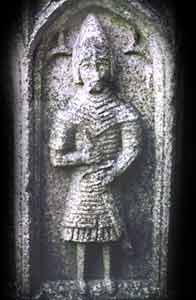
One Elizabethan observer reported that
"a battle of Galloglaich be 60 or 80 men harnessed on foot with sparrs, every one whereof hath his knave to bear his harness, whereof some have spears, some have bows"
The Galloglaich that were 'established' or owned land were usually accompanied by two Kern or a kern and a younger horseboy.
This trio fought as a unit called a 'Sparr', the name taken from the axe wielded by the Galloglaich; the armoured Galloglaich would fight to the front supported by the kern with the pole arm while the horseboy showered the enemy with darts before the spar could make contact possibly opening up a gap in the enemy lines. The horseboy would then either retire or if similarly armed to the Kern fought alongside the Galloglaich.
These men were well paid, the Galloglaich receiving three Cattle per season as well as his victuals in the form of butter, pork and corn meal. In open battle the Galloglaich were grouped together into a unit which was called the Corrughadh or 'Battle'. This was anything from between 60-100 Galloglaich in addition to their Kern retainers. So a fully manned Corrughadh could in theory contain up to 300 men. In reality this was hardly the case and in most instances a Corrughadh was usually up to 80 Galloglaich with whatever Kern and horseboys they could muster.
Commanding the Corrughadh was a Consapal or 'Captain' and were generally Galloglaich themselves. The consapal received payment annually of 36 cattle, victuals equivalent to that of man, a war-horse and hack. The consapal was allowed a shortfall of 13 men, whose pay went to the Consapal. The Consapal was also fined for missing men and equipment - 2 cows fine per missing man (1 for the man and 1 for his armour), a shilling for a missing Sparth, and a groat for a missing spear. The lack of a helmet was not fined since the death of the Galloglaich in battle was sufficient punishment. By 1512 there were reported to be 59 Corrughadh through Ireland in the employ of various Chieftains and Lords.
In Irish warfare the Galloglaich were used in the open field against other Irish armies but when they encountered the more heavily armed and armoured English troops Irish commanders preferred to use them as shock troops in ambush. While capable of meeting the English in the open they were usually outnumbered and they were especially susceptible to archers. The Irish chiefs knew the worth of their Galloglaich and would not throw them away in such a foolhardy venture. They Irish would harass the enemy from woodland or a pass with Kern Skirmishers and lured them into giving chase. After reaching difficult terrain they would then be suddenly attacked from the flanks by the Galloglaich who usually made short work of the disorganised soldiers. This tactic worked time and time again and English commanders would be understandably wary when passing through the numerous passes and thickly forested woodland of the Irish Countryside.

with a long broad axe in his hand.. .yet sure they are valiant and hardie,
for the most part great endurers of cold, labour, and all hardnesse,
very active and strong of hand, very swift of foot,
very diligent and circumspect in their enterprises"
For definitions of the terminology please refer to the Medieval Irish Glossary
Basic Clothing
Leine
Mostly Saffron but any earth colour will do. The Leine for the Galloglaich is consistently shown with closed sleeves all the way down to the wrist with the hem reaching below the knee.
A Leather Belt or Crois
Worn around the Leine's waist. For a Leather belt a ring buckle was common among the Irish but any period Scots-Irish or Anglo-Irish buckle will do. The Crois was usually made from woven wool or plaited leather.
Rectangular Brat or Semi-circular Mantle
While the Galloglaich is not shown to be wearing mantles or brats either in the Hebridean/Irish tomb-slab effigies or illustrations on Irish Galloglaich the Irish mantle was widely respected amongst both English and European armies to the point of these mantles being supplied to those soldiers on campaign. Taking this point into account and with the availability of the Irish Mantles to the powerful Galloglaich families it is extremely unlikely that they would have done without this important piece of equipment (especially with the Irish weather).
An Ionar or Shirt
An Ionar or shirt could be worn over the leine (note: at the time of the medieval period the meaning for leine and the modern meaning are different). This is long sleeved and of the closed variety. Normally the Ionar is made from wool or linen but can easily be made from a material available from Europe at this time.
Shoes
Galloglaich are normally depicted as wearing shoes whether they be of Irish or English type but in some instances they are depicted as going barefoot. Again for safety reasons it is better that you wear these shoes when walking around either a battlefield or with the public unless in a Living History area where the choice is yours.
Braies or Hose
Trews or hose are shown on some Galloglaich in English service, most Galloglaich however are depicted as barelegged.
Basic Weapons and Equipment
The following would seem to be the minimum equipment for a Galloglaich on the battlefield.
Two-handed weapons
The famous 'Sparth' or Galloglaich axe, approximately 6ft long (various heads of several different styles and shapes have been found in Ireland), was by far the most common weapon.
There are also a few depictions of medium-length spears being used by Galloglaich though they were invariably armed with the as their trademark weapon.
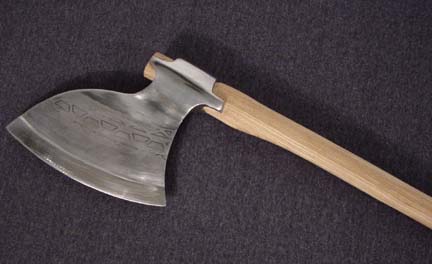
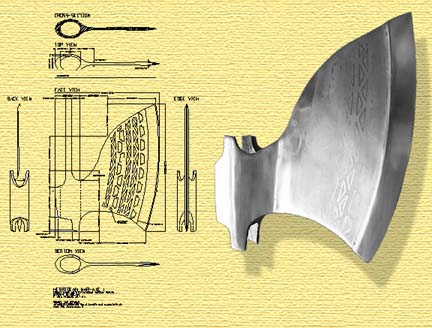
Most Galloglaich were equipped with a helmet and in fact the fine for the loss of a helmet by a Galloglach was to be his own brains meaning any injury suffered in battle were deemed to be his own fault.
The most common type recognised from the effigies is a type of Bascinet as shown in the pictures below though any period Irish or English helmet can be used for both Living History and Combat.
Presumably these helmets should also have a leather/padded lining to them.
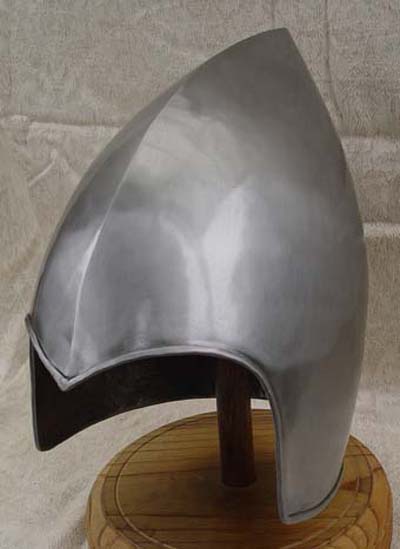
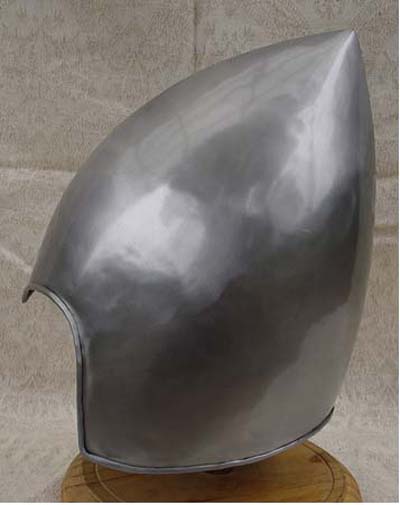
An Aketon or Cot�n made of heavy linen (sometimes lined externally with pitch or faced with deer hide) stuffed with an appropriate padding material would have very common for a Galloglaich.
Advanced Weapons and Equipment
Mail Hauberk
A mail hauberk reaching to at least mid-thigh with either elbow-length or wrist length sleeves worn over the Aketon.
Mail Pisane or Standard
A mail Pisane or Standard was sometimes worn alone with an Aketon or in conjunction with a hauberk. (This may include either dagged or straight edges to its� lower fringe.)
Scian or Dagger & Scabbard
A full length scian or period dagger hanging from the belt.
An example of a scian is shown below

Any period Irish or Anglo-Irish style sword worn on a belt around the waist would be acceptable.
The example shown below with the dropped quillons is of a type used in Medieval Ireland that was available to the Galloglach

At a mid-to-later period various great-swords and claymores were used in Ireland but these were mostly attributed to the Redshank Scottish mercenaries of the later periods.
Safety Note
For those of you portraying a Galloglaich on a battlefield I highly advise some kind of gauntlets as the amount of injuries to the hands from weapons sliding down a shaft is unreal in addition to which there is no depiction nor written account (available to me anyways) of a Galloglaich using a shield, therefore you will be forced to parry with the weapon exposing your fingers and thumbs to all those fast moving pieces of metal trying to hit you. For those of you doing Living history with a sharp Galloglaich axe especially, keep a firm grip on it at all times as it cannot be sheathed and was designed to cleave through anything that moves.
An idea might be that if a kern could have an all metal gauntlet than a Galloglaich could too but this might be taking an �artistic licence� too far.
Bits� n� Pieces
Large Pouches or bag to carry the following - The �Bollock� Pouch (Kidney Shaped) is a popular medieval example.
Ring Brooches (for Brat or Cloak)were used throughout Ireland and Europe
Basic Sewing Kit (for Cloth and Leather)
Tinderbox or pouch with tinder, flint, & iron striker
Bowl and/or plate, spoon, utility knife or short scian (sharp) & period drinking vessel.
Rag & polish for armour and weapons
Whetstone
(See 'A Sparr on Campaign' page for pictures)
Living History
If you are portraying a Galloglaich of the mid fourteenth century you should make a point that you are a �settled� mercenary (permanently employed) and a member of a hereditary retainer family of a particular Irish Lordship.
The food used would mainly be Pork, Beef, Butter and Corn-meal (these are their salary)
Also For Decorating Surfaces i.e. Leather/Wood Carving, Engraving, and Embroidery it would be worth checking out designs from Medieval Irish Artwork ranging from the Romanesque Stone Carvings of Monasteries and Bibles from the Period you want to do and Medeival Scotland, in particular the Hebrides of the same period.
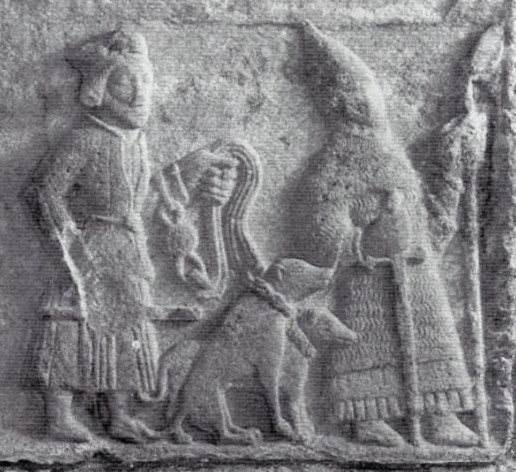
The Sparr is a definitive grouping for a retainer Galloglaich. If you intend to portray a �Sparr� you might want to consider getting two people to accompany you as either two Kern or a Kern and a Horseboy. The kern was usually armed with at least a pole-arm while the other had either darts or a bow). Also, the kern would carry the Galloglaich armour when not fighting and the other Horseboy or Kern would carry food and utensils for all three as wells as preparing the campsite every evening. (Handy for Living History)
Miscellaneous
Historical evidence shows that Galloglaich could be either clean-shaven, with a beard or with a croimeal (moustache). Hair could be of any length and style, ie the 'Glib' , but keeping in mind that coifs and helmets were worn these would, at a guess, have been short
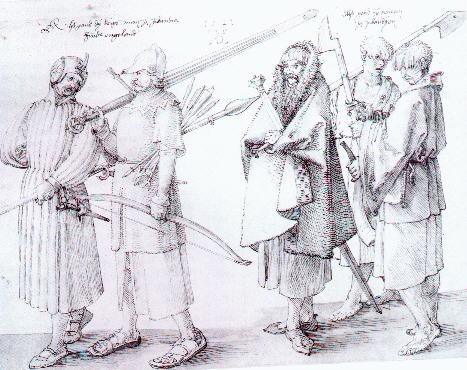

The multiplying villanies of nature do swarm upon him) from the Western Isles
Of Kerns and Gallowglasses is supplied.
For the Full List of Annals please use this Link - CELT: Corpus of Electronic Literary Text
A great migratory incursion was made by the Clann-Muircertaigh into Magh-Nissi, and an attack was made by them on the people of Magh-Luirg, namely, by Tadhg, son of Ruaidhri Ua Conchobuir and by the nobles of his people, together with their great muster that is, with Fergal Mag Tigerna[i]n, chief of Tellach Dunchada and by Diarmait Mag Raghnaill, chief of Muinter-Eolu[i]s, along with a muster of Gaidhil and Galloglaich. The stronghold of Aedh Mac Diarmata was burned by them. Fergal Mac Diarmata, king of Magh-Luirg and Aedh Mac Diarmata rose out in that movement. An onset and attack of cavalry exclusively was given to each other at Ait-tighi-Mic-Coise and decisive defeat was inflicted on the people of Magh-Luirg and twelve persons were killed of the favourite nobles of Mac Diarmata and Aedh himself was injured there. And Mac Diarmata and Aedh Mac Diarmata took charge of the rear of their people spiritedly and powerfully from that out.
U1364.9
Great defeat (the Defeat of the Strand of Eothail) was inflicted byDomnall, son of Muircertach and by Muinter-Ruairc and by Mac Donnchaidh andby Theobald de Burgh with their retained kerns on Tadhg, son of Maghnus. And they were overtaken on the Strand of Eothail and the Galloglaich of the son of Maghnus were slain there�seven score and ten�under Domnall, sonof Somairle and under Domnall junior, his son and under the two sons of Mac Suibhne and under the son of the bishop Ua Dubhda and under William Mac Sithigi.
U1365.9
A great hosting was made by Niall Ua Neill, [namely], by the king of Ulster and one worthy to be arch-king of Ireland, into Oirghialla and the nobles of all the Fifth rose out with him for a leaguer on Brian Mac Mathgamna. And a fortified position was taken up in the midst of the territory by UaNeill. And large donatives were proffered from Brian Mag Mathgamna to Ua Neill: to wit, half of Oirghialla to be given to Niall, son of Murchadh,[namely] to the king that was before that in the country and large donatives in payment [of the death] of Mac Domnaill from him likewise. Ua Neill indeed consented to that. But a compact was made by the son ofMurchadh Mag Mathgamna (namely, Niall), and byAlexander Mac Domnaill, [that is] by the lord of the Galloglaich and they went, without leave from Ua Neill, three equal, manageable battalions, to attack Mag Mathgamna. And a camp-attack was delivered by them on him and Mag Mathgamna rose out with the whole of his forces and his noble muster against them. And victory was gained from the [attacking] host by them and the son of Murchadh Mag Mathgamna (namely, Niall), heir of Oirgialla, was slain there and Alexander junior, son of Toirdelbach Mac Domnaill, Constable of the Galloglaich and heir of the Clann-Domnaill, was slain there and Eogan junior, son of Toirdelbach, son of Mail-Sechlainn Ua Domnaill was slain there along with many others.
U1368.1
Brian Mor Mac Mathgamna, arch-king of Oirgialla, the hand that most slew of the Foreigners and of the Gaidhil of Ireland in his own time [was] that man and he went against the Foreigners and a Galloglaich of his own people fell upon him treacherously in a solitary place and he was slain by him and [the assassin] himself escaped thereafter.
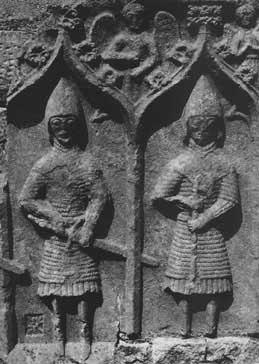
Hugh O'Rourke, Lord of Breifny, was slain by Cathal, the son of Hugh the Breifneach O'Conor and the Clann-Murtough, and a great slaughter was made of the Galloglaich of the Mac Sweenys on the occasion.
M1366.7
A victory was gained by Teige, the son of Manus O'Conor, over John O'Donnell and his Galloglaich. Many were slain in the conflict; and Mac Sweeny and many of the chiefs of Tirconnell were taken and led away prisoners.
M1367.3
The Clann-Murtough came upon a migratory excursion to Magh-nisse, and made an incursion into: Moylurg. The most illustrious of those who set out on this incursion were Teige, son of Rory O'Conor; Farrell Mac Tiernan, Lord of Teallach Dunchadha; and Dermot Mac Rannall, Lord of Muintir-Eolais: these were accompanied by many Galloglaich. They burned the fortified residence of Hugh Mac Dermot; but Farrell Mac Dermot and Hugh Mac Dermot, Lord of Moylurg, opposed them; and a battle ensued, in which many were slain on both sides. Teige O'Conor and Mac Rannall then returned, without having gained either booty or consideration.
M1367.4
A victory was gained by Donnell, the son of Murtough O'Conor, the O'Rourkes, and the Clann-Donough, with their retained kerns, over Teige,the son of Manus, on Traigh Eothuile an t-Saoir. The Galloglaich of the son of Manus, one hundred and fifty in number, were slain; as were also Donnell son of Sorley, Donnell Oge, his son, the two Mac Sweenys, the son of the Bishop O'Dowda, and William Mac Sheehy.
M1368.12
A great army was led by Niall O'Neill, King of the Kinel-Owen, who was joined by the chieftains of the entire province of Ulster, into Oriel, to attack Brian Mac Mahon; and they pitched a camp in the very centre of the territory. Mac Mahon offered him great terms, namely, to cede one-half of the territory of Oriel to Niall, the son ofMurrough son of Brian nag-Coileach n-Oifrinn, i.e. he who had been lord over the territory before himself; and other great gifts to O'Neill himself, as eric for the death of Mac Donnell. O'Neill consented to make peace with him on these conditions; but the son of Murrough Mac Mahon and Alexander Oge Mac Donnell, Lord of the Galloglaich, without O'Neill's permission, marched, with one accord, with three battalions of kerns against Mac Mahon, and made an assault upon his fortress; but Mac Mahon and his household, being upon their guard, armed and accoutred within their fortress, they responded without delay to the attack; and a fierce and furious conflict ensued, in which they the assailants were defeated by Mac Mahon. The son of Murrough Mac Mahon, Tanist of Oriel; Alexander, the son of Turlough Mac Donnell, Constable of the Galloglaich; and Owen, the son of Turlough, son of Melaghlin O'Donnell, together with a great number of others, were slain on that occasion.
M1372.1
Brian More Mac Mahon, Lord of Oriel, marched to give battle to the English; but he was privily and treacherously
slain by a Galloglaich of his own people, who there upon fled from the army.
M1388.8
Donnell O'Conor made an incursion into Machaire-Connacht, and burned Ard-an-Choillin, and the island Loch-Cairrgin.
Donnell Oge Mac Donnell (i.e. a constable of Galloglaich) was slain on this excursion.
M1397.6
Mac Donough of Tirerril repaired to Machaire-Chonnacht with all his forces. Substance, and cattle, to assist O'Conor Don,
and encamped with his people and cattle at Cuirrech-Chinn-eitigh, where O'Conor was. O'Conor Roe having heard of this,
he assembled together, from every side, Mac William, Thomas, the son of Sir Edmond Albanagh, the sons of Cathal Oge O'Conor,the sons of Hugh Mac Dermot, the Hy-Many, and even the grandsons of Felim, with all the forces of each of them, and a body of Galloglaich besides; and these then marched to the Plain of Machaire Chonnacht. But O'Conor Don was not then along with Mac Donough, nor did Mac Donough perceive the army until O'Conor Roe had surrounded him with a large body of cavalry. A battle ensued between them, which was fiercely and determinedly maintained on both sides, until at length Mac Donough and his people were defeated; and the heroes by whom they were routed pursued and slaughtered them).
In this engagement were slain Mac Donough, and Hugh Caech, the son of Hugh, son of Turlough O'Conor; Mac Sweeny, High Constable of Connaught from the Mountain downward, and his two brothers, Donough and Donslevy; Cuaifne, the son of Cuaifne O'Conor; and Dermot Mac Donough, Tanist of Tirerrill; together with other chieftains and nobles of their kinsmen and people. Innumerable and indescribable were the spoils and valuable articles obtained by O'Conor Roe on this occasion, without mentioning horses, arms, and armour. This defeat of Cinn-eitigh was sustained on the first festival of the Blessed Virgin Mary in autumn. When O'Conor Don had heard the news of this (which he did on the third day after the defeat), he came to the herds and stalls of O'Conor Roe and the Clann-Felim, which were situated in Leitrim, and having given them a migratory overthrow, which was called �an gheal-mhaidhm,� he carried off from them immense preys and spoils on that occasion.
M1397.8
At this time Murtough Bacagh, the son of Donnell, son of Murtough O'Conor, and the MacSweeneys, were at Fassa Coille,
together with the Western O'Hara, and the descendants of Flaherty O'Rourke; and they all set out early in the morning to Bun-Brenoige, opposite Lissadill, to attack the sons of Cathal Oge and O'Donnell. Squadrons of the cavalry of the sons
of Cathal Oge advanced towards them the party of Murtough Bacach, on the way to Sligo; but the stream of Bun-Brenoige
lay on one side of them, and, luckily and favourably for them, the sea had flowed on the other side, so that they could not be encompassed or surrounded. They afterwards came to a brisk engagement with each other, in which O'Donnell and the sons of Cathal Oge were defeated, and Marcus Mac Donnell, and Dugald his son, John Mac Sheely, and a great many others of their Galloglaich, were slain. Great ravages and depredations were then committed on the sons of Cathal; and they were again banished across the River Erne, in sadness and dejection, precisely on the Great Festival of the Blessed Virgin Mary.
M1416.13
Another incursion was made by Hugh Boy and Teige O'Rourke, and by Mac Cabe, into Muintir-Pheodachain. The people of Fermanagh, dwelling west of Lough Erned, came up with them, as did also Cathal O'Rourke and Owen O'Rourke. The sons of O'Rourke sustained the attacks of the overwhelming numbers that pursued them, until they arrived at the place where they had left their Galloglaich in ambush; both parties then turned upon their pursuers, and slew Donough and John O'Rourke, and the two sons of Melaghlin, the son of Flaherty O'Rourke, together with forty-eight of the men of Fermanagh.
M1422.12
The same Niall O'Donnell assembled together all the chiefs of the province, namely, O'Neill, and the sons of Henry O'Neill; Owen O'Neill, with his sons and kinsmen; the sons of Cu-Uladh Roe O'Neill; the people of Fermanagh and Oriel, under the conduct of Mac Mahon and Maguire; Magennis, O'Hanlon, and Mac-I-Neill Boy, with his forces; the O'Kanes and the Kinel-Connell themselves, with their Galloglaich, and also the English of the province; and they all set out upon an expedition into Connaught. They were drawn upon this expedition by the sons of Cormac Mac Donough, and the sons of Mulrony Mac Donough, who had been banished from their country by their paternal uncle, Mac Donough, by Conor Mac Donough and his sons, and by Cormac Oge Mac Donough. For Mac Donough had erected a castle in the territory of the sons of Mulrony Mac Donough, that is, at Caiseal Locha-Deargain, and had entirely destroyed their crops and fields, and afterwards banished them to Mac William Burke; wherefore, they drew this great army to devastate Lower i.e. North Connaught.
M1424.6
Many Saxons came to Ireland with the Earl of Ormond, in consequence whereof the English of Ireland acquired great strength. Great depredations were committed by the Earl, by his Saxons, and the Galls of Meath in Machaire Arda Macha, and Machaire Mucnamha. Another excursion was made by them against Magennis, and they demolished his castle of Loch Bricrenn; and killed the Constable of his Galloglaich, and almost the whole of the ward in the castle. War and great disturbance were kindled in Ulster on this occasion by the English. The greater part of nobles of the province, both lords, dynasts, and toparchs, with O'Neill, O'Donnell (Niall), and Owen O�Neill at their head assembled their forces to oppose the English. Some of the nobles of the province, however, went over to the English in this war, namely, Mac-I-Neill Boy, O'Hanlon, and Manus Mac Mahon. Magennis was banished from his territory by Mac-I-Neill Boy, and the English and he went over to the Irish of the province.
M1424.13
Rory Mac Sweeny, son of Mac Sweeny Connachtach, and other Galloglaich, were slain by Cathal Duv O'Conor; and Conor, the son of Murtough, son of Cathal, son of Hugh Breifneach O'Conor, was also slain on this occasion.
M1429.5
A war broke out between O'Rourke (Teige) and O'Reilly (Owen). The descendants of Mahon O'Reilly and the English of Meath joined O�Rourke against O'Reilly, and burned O'Reilly's town, whereupon O'Reilly prevailed upon O'Neill to come to his relief; and O'Neill, with the forces of Oriel and Fermanagh, and his own creaghts, marched as far as Achadh-Chille-Moire.Thither they were pursued by O'Rourke, the sons of Mahon O'Reilly, the Baron of Delvin, and Mac Cabe; and O'Neill and his sons and Galloglaich, in conjunction with the forces of Fermanagh, and O'Reilly and his kinsmen, then engaged, and defeated the enemy in the battle of Achadh-Chille-Moire, in which the Baron of Delvin, Mac Cabe, Henry Mac Cabe, Dermot O'Rourke, and many others, were taken prisoners or slain by O'Neill.
M1435.10
Now O'Neill, his sons, and Mac Donnell Galloglaich, felt shame and disgrace at their expulsion from the position in which they were fortified; and there solution they adopted, at the request and solicitation of Henry O�Neill, was, that they should attack the camp, and use their boldest exertions tore-take it. Henry's exciting exhortation had great effect upon the minds of the youths, and they attacked the camp vigorously, silently, and fiercely, Henry being the foremost in the van, until they made their way into the very centre of their enemies. Mac Donnell Galloglaich and Mac Sweeny Fanad then came to an engagement, in which heroes were mangled and slaughtered between them on both sides; and such was the confusion that prevailed, owing to the darkness of the night, and the closeness of the combatants to each other, that friend could not be distinguished from foe. Sparks of fire flashed from the helmets of the heroes and the armour of the champions. Hugh O'Neill and Brian O'Neill came to a personal rencounter with each other; and Hugh made a thrust of his spear at Brian, and wounded him severely, after which Brian and Naghtan withdrew from the contest and left their Galloglaich behind them. When Mac Sweeny the leader of the Galloglaich perceived that Naghtan and Brian Oge had gone away from him, he sent his people before him, and remained himself in the rear to cover their retreat, and left the place without O'Neill's knowledge; but when Henry and his kinsmen observed this, they pursued Mac Sweeny to Slieve Truim, and there defeated him, and took himself and many of his people prisoners. O'Neill was victorious on this expedition.
Literary References
Galloglass: Hebridean and West Highland Mercenary Warrior Kindreds in Medieval Ireland (John Marsden)
Scots Mercenary Forces in Ireland 1565-1603 (Burns, Oates and Washborne)
West Highland Mercenaries in Ireland (Andrew McKerral)
A Concise History of Scotland (Fitzroy MacLean)
A Military History of Ireland (Thomas Bartlett, Keith Jeffery)
The Lords of the Isles (Ronald Wilson)
The Wars of the Bruces (C MacNamee)
Angus Og of the Isles 1963 (I E Grant's)
Pictures of products made byAlbion Amorers are used with permission

